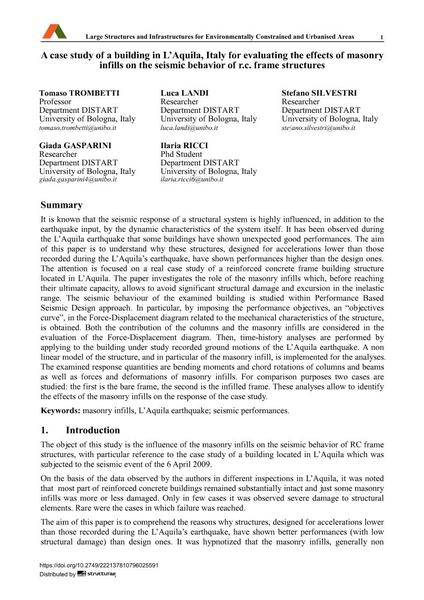A case study of a building in L’Aquila, Italy for evaluating the effects of masonry infills on the seismic behavior of r.c. frame structures

|
|
|||||||||||
Détails bibliographiques
| Auteur(s): |
Tomaso Trombetti
Luca Landi Stefano Silvestri Giada Gasparini Ilaria Ricci |
||||
|---|---|---|---|---|---|
| Médium: | papier de conférence | ||||
| Langue(s): | anglais | ||||
| Conférence: | IABSE Symposium: Large Structures and Infrastructures for Environmentally Constrained and Urbanised Areas, Venice, Italy, 22-24 September 2010 | ||||
| Publié dans: | IABSE Symposium Venice 2010 | ||||
|
|||||
| Page(s): | 508-509 | ||||
| Nombre total de pages (du PDF): | 7 | ||||
| Année: | 2010 | ||||
| DOI: | 10.2749/222137810796025591 | ||||
| Abstrait: |
It is known that the seismic response of a structural system is highly influenced, in addition to the earthquake input, by the dynamic characteristics of the system itself. It has been observed during the L’Aquila earthquake that some buildings have shown unexpected good performances. The aim of this paper is to understand why these structures, designed for accelerations lower than those recorded during the L’Aquila’s earthquake, have shown performances higher than the design ones. The attention is focused on a real case study of a reinforced concrete frame building structure located in L’Aquila. The paper investigates the role of the masonry infills which, before reaching their ultimate capacity, allows to avoid significant structural damage and excursion in the inelastic range. The seismic behaviour of the examined building is studied within Performance Based Seismic Design approach. In particular, by imposing the performance objectives, an “objectives curve”, in the Force-Displacement diagram related to the mechanical characteristics of the structure, is obtained. Both the contribution of the columns and the masonry infills are considered in the evaluation of the Force-Displacement diagram. Then, time-history analyses are performed by applying to the building under study recorded ground motions of the L’Aquila earthquake. A non linear model of the structure, and in particular of the masonry infill, is implemented for the analyses. The examined response quantities are bending moments and chord rotations of columns and beams as well as forces and deformations of masonry infills. For comparison purposes two cases are studied: the first is the bare frame, the second is the infilled frame. These analyses allow to identify the effects of the masonry infills on the response of the case study. |
||||
